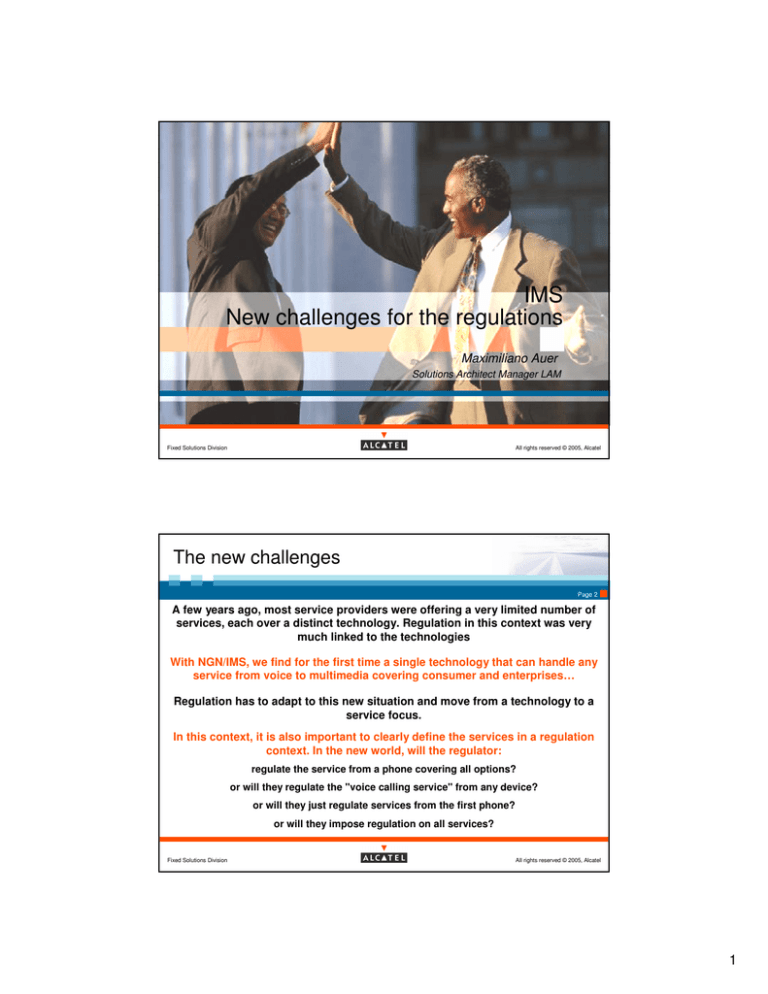
IMS
New challenges for the regulations
Maximiliano Auer
Solutions Architect Manager LAM
Fixed Solutions Division
All rights reserved © 2005, Alcatel
The new challenges
Page 2
A few years ago, most service providers were offering a very limited number of
services, each over a distinct technology. Regulation in this context was very
much linked to the technologies
With NGN/IMS, we find for the first time a single technology that can handle any
service from voice to multimedia covering consumer and enterprises…
Regulation has to adapt to this new situation and move from a technology to a
service focus.
In this context, it is also important to clearly define the services in a regulation
context. In the new world, will the regulator:
regulate the service from a phone covering all options?
or will they regulate the "voice calling service" from any device?
or will they just regulate services from the first phone?
or will they impose regulation on all services?
Fixed Solutions Division
All rights reserved © 2005, Alcatel
1
The IMS/TISPAN vision
A Layered Architecture
Page 3
Application Servers
Applications
Layer
CSCF
MGCF
Control Layer
IMS CORE
QoS & Security
Layer
PDF/ABCF
PEF/ABGF
Transport
Layer
HSS
3G/NGN
Terminals
IBCF
IWF
Trunking GWs
Signaling GWs
PSTN/PLMN
Legacy
Fixed Solutions Division
IBGF
IP Peering
All rights reserved © 2005, Alcatel
VoIP, To regulate or not To… ???
Different scenarios, different rules…
Page 4
PES (PSTN Emulation Service)
Normal Twisted-Pair based POTS, with VoIP infrastructure only on Carrier premises.
No mobility possible. Geographically dependant fixed numbers.
Same price policy as fixed legacy lines.
Replaces Legacy POTS service, and as such it shall fulfill actual regulation compliancy.
Broadband based VoIp
POTS and/or Multimedia service that requires BB access, and connects with PSTN.
Nomadicity: numbers are not related to Geographical position of the user (USA, Australia,
Europe). Some countries will use Location Independent Ranges (“dummy” area codes).
“Long Distance Calls” are meaningless. New tariff rates should apply.
It does not require to fulfill all regulations as previous services (USA), unless it’s used as
“First Line” service (Europe). In Australia, a POT alternative service shall be available.
The tendency is to slightly regulate this service.
Fixed Solutions Division
All rights reserved © 2005, Alcatel
2
VoIP, To regulate or not To… ???
Different scenarios, different rules…
Page 5
Internet based “Free VoIp”
Peer-to-Peer sessions that does not connect with PSTN
Legal in most countries (USA, Australia, Europe). Tendency is not to regulate them.
Cannot be blocked by provider (USA), unless indicated on the contract (Australia). Trends
on Europe shows blocking will be illegal. Most of the operators are not blocking it.
QoS can not be assured.
The tendency is to fight against them with better quality services, with local PSTN
connection and advanced services.
The previous scenarios shall be regulated in different ways, because are different
services, with different characteristics and purposes.
Fixed Solutions Division
All rights reserved © 2005, Alcatel
Beat Skype at their own game….
…And provide better services to end users
Page 6
IP to IP, IP to PSTN, PSTN to IP Calls
Call waiting
Call Forwarding based services
Three party conference
Video Calls – Video Conference
Voice Mail
Buddy List, Chat & Presence
Data Sharing
Fixed Solutions Division
All rights reserved © 2005, Alcatel
3
Page 7
Examples of Regulatory Services
Fixed Solutions Division
All rights reserved © 2005, Alcatel
Mandatory Features: Lawful Intercept
Easy to do in Legacy, but….
Page 8
Law Enforcement Agency
Mandatory in most countries, at least
when service interconnects with PSTN.
Hard to do for Internet peer-to-peer
calls.
IMS proposes Voice Encryption only on
the access network.
New services shall be included:
Which service this will apply to?
What about Video Calling?
Int. Request
Interception
Management
Copy of
RTP
Policy Decision
Policy Enforcement
Access
Network
Fixed Solutions Division
Copy of
Signaling
Call & Session
Control
Function
Trunking
Gateway
PSTN/PLMN
Legacy
All rights reserved © 2005, Alcatel
4
Mandatory Features: Location
Easy to do in Legacy, but….
Page 9
Nomadicity requires ability to dynamically determine customer location at
time of Service registration
User location is determined at time of
registration.
When receiving the Registration
message, the P-CSCF will query the
RAC/NASS function, collecting user
location information.
Info is returned to the P-CSCF which
inserts it into the Register message, and
forwards up the info.
At the end, the info is stored on the Users
Database (HSS)
IMS
CORE
PCSCF
RACS
NASS
IP
DSLAM
BAS
ADSL
Network
A critical Feature for Emergency Services
Fixed Solutions Division
All rights reserved © 2005, Alcatel
Mandatory Features: QoS assurance
Easy to do in Legacy, but….
Page 10
IMS provides means for controlling, assuring and reporting QoS.
¿Does user expects PSTN voice quality, at least for paid
services?
Shall this be regulated? Or will remain unregulated and
considered an asset leading to additional revenues?
Shall minimum QoS level be imposed?
Shall a call be rejected if QoS level can not be assured?
Shall a user have access to QoS Reports?
WiMax
3G
When a new call is requested, the
PDF checks resource availability &
policy vs resources requested.
BS
IMS If needed, access elements are
Core requested to increase user BW.
IP
ADSL
MPLS
Fixed Solutions Division
BAS
DSLAM
PDF
IP Packets are marked with DiffServ
to have priority on the IP Transport.
All rights reserved © 2005, Alcatel
5
Mandatory Features: Lifeline Support
Easy to do in Legacy, but….
Page 11
This is not an issue for PES systems
The VoIP is implemented on the Carrier’s side of the network. User keeps its classic
POT service over the a/b wire with remote feeding etc.
Requires some extra effort for a wireline Broadband VoIp operator:
There’re IADs available with automatic switching to POT line in case of failures.
This will mean classical POT service shall remain, either with Legacy or NGN-PES
infrastructure.
Internet
QoS VoIP
Not possible to implement on a wireless Broadband VoIP operator.
Several countries do not consider this as mandatory
Service shall be available only if user request it, and under the figure of a Legacy
or NGN-PES POT service.
Fixed Solutions Division
All rights reserved © 2005, Alcatel
The Australian’s situation
Beautiful things that do not combine together
Page 12
All access providers need to set the SAME PRICE for the SAME SERVICE in all parts
of Australia:
In order to break even when offering services to remote parts of the country, the access
provider needs to charge more for services in the cities, and use the extra revenue to
offset the losses outside the city.
The regulator can force Telstra to unbundle DSL services.Telstra can only ask cost
plus for unbundled loops:
As loops in the city are much less expensive to maintain than loops in the country, the
regulator forces Telstra to charge less for unbundled city loops.
Competitors are not forced to offer services everywhere. So, they can offer services
only where wholesale costs are low, and meet the obligation to offer national pricing,
offering at the same time cheaper prices than Telstra.
So, if Telstra wants to do national-wide investments for leveraging the service, they’ll
see that their investment in the most profitable areas will be used by competitors in order
to provide cheaper services and increment their market-share. Users will choose on that
areas to go with competition due to lower prices than Telstra.
Fixed Solutions Division
All rights reserved © 2005, Alcatel
6
Page 13
www.alcatel.com
Fixed Solutions Division
All rights reserved © 2005, Alcatel
7


